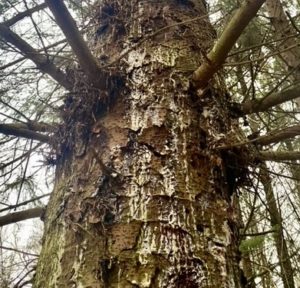Fungi helping bark beetles !

The woodlands blog has previously reported on the damage being wreaked by bark beetles. These beetles may be small (less than a centimetre in length) but their effects on the western forests of North America has been immense. Some areas have lost 90% of their conifers. Outbreaks of these beetles have been increasing in size and severity. Indeed, across Europe, the eurasian bark beetle (Its typographus) has killed millions of conifers.
Whilst bark is broadly protective, it can also offer a home to certain insects. Bark beetles lay their eggs just below the bark so that when the larvae hatch, they can feed on the nutrient-rich living tissue of the cambium and phloem. Consequently, the tree's transport systems begin to fail. The beetles may also introduce disease-causing fungi and bacteria. Ageing stands of trees coupled with warmer winters, which help the overwintering stage of the insect, have contributed to the spread of bark beetles. .
Conifers, by their nature, are not defenceless. When a pine tree is cut / wounded, it produces a pale yellow and sticky fluid - RESIN to seal the cut or wound [see above image]. This material helps prevent the entry of pests or pathogens, and can stem water loss. The resin may trap insect invaders as witnessed by those trapped in time capsules of amber. Resin is rich in terpenes, these are used in the building of many complex organic molecules and contribute to the make-up of the volatile oils, produced by many plants. Terpenes are made from units of isoprene, which has the formula C5H8. So the basic formula of a terpene is (C5H8)n, where n is the number of isoprene units that have been joined together. Terpenes are also readily available in coniferous oils, which contribute to the unique smell of a pine forest or a burning log.

Old and dying tree
These ‘chemical defences’ should trap, poison or deter an insect invader, such as the bark beetle. But it would seem that bark beetles ‘don’t mind’ these defences. Research suggests that the eurasian bark beetle might have an ally.
Certain fungi (from the genus - Grosmannia) are found in association with these beetles. When the Grosmannia fungi infect spruce trees they alter the chemical profile the trees, so that infected trees produce different volatile chemicals - ie they smell different. The bark beetles are able to detect these differences and exploit this ‘breach’ of the trees natural defences. The unique chemical profile of infected trees and the pheromones produced by the beetles probably help explain the swarming behaviour of the bark beetles. A heavy beetle infestation results in the death of a tree.
However, there is a possible positive in this rather sad tale. At present, traps for bark beetles rely solely on using pheromones but if the pheromones can be combined with the chemicals produced by the fungi then it opens the door to more effective beetle traps.
Comments are closed for this post.
